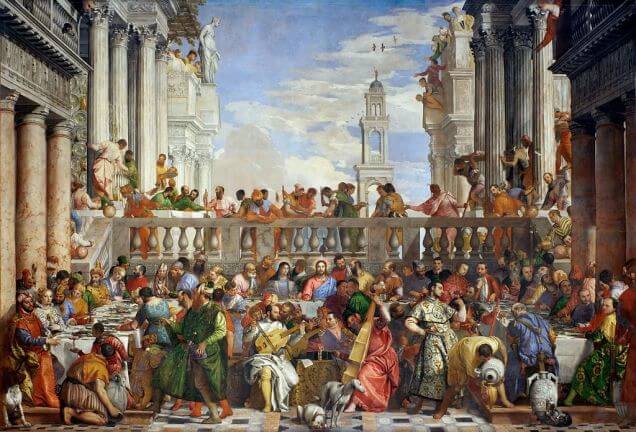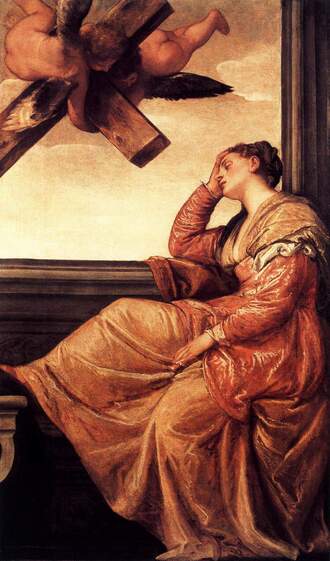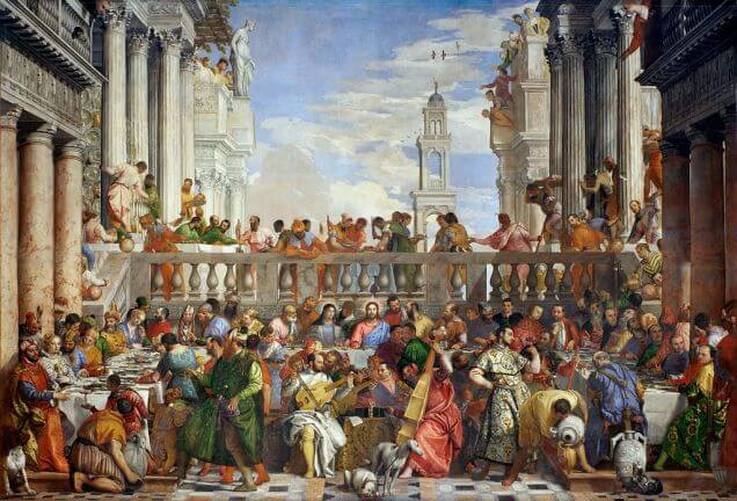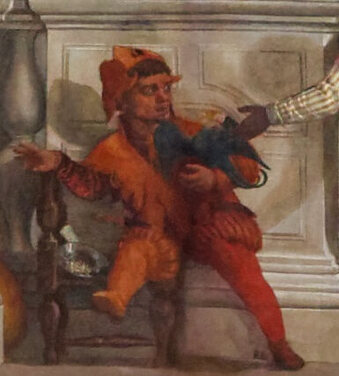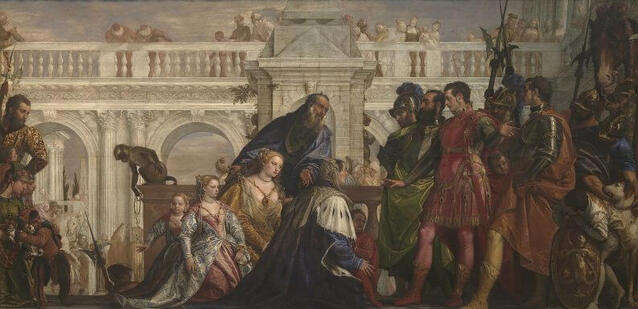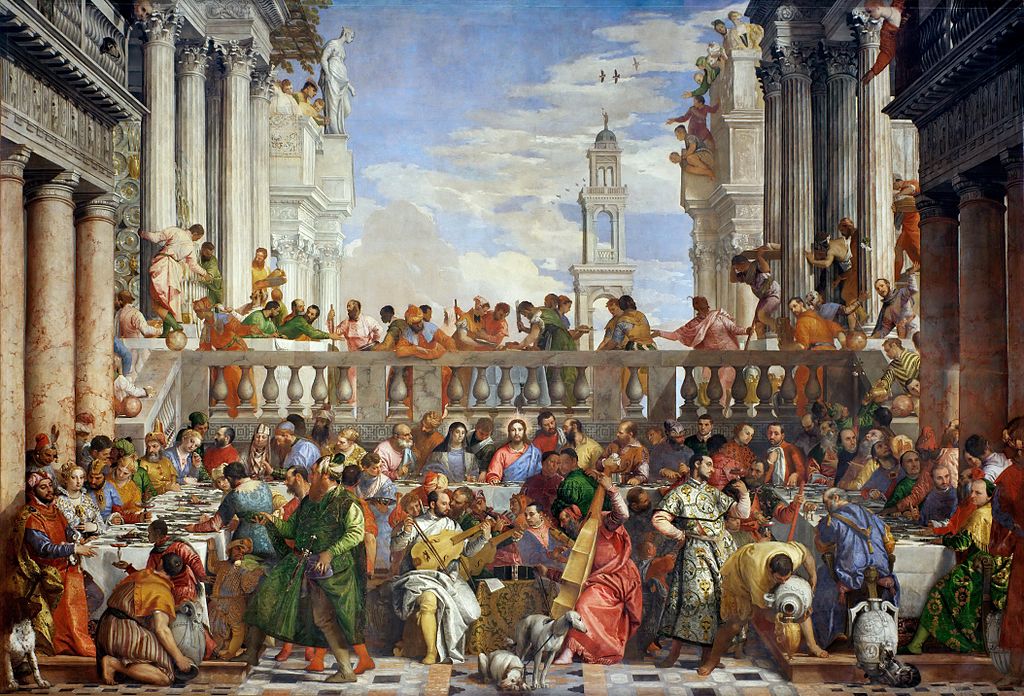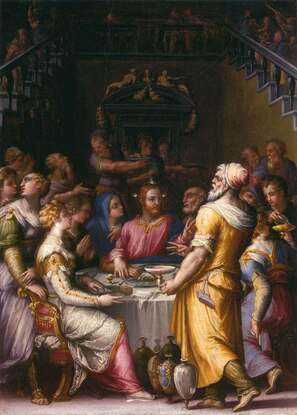|
Where? Room 9 of the National Gallery
When? 1565-1570 Commissioned by? The Pisano family, probably Francesco Pisani What do you see? This painting is full of activity. The main attention goes to the two groups of life-size people in the foreground. The painting shows how the family of Persian King Darius (in the center) appears in front of King Alexander the Great and his following (on the right) to ask for mercy. The man on the right, dressed in red and gold, is Alexander the Great. To his right, with the orange cape, is his good friend and advisor Hephaistion who is pointing to himself. Alexander is further surrounded by other high-ranked officers in his army, some of which a carrying a weapon called a halberd. The woman in blue in the center foreground is the mother of Darius, Sisygambis. She is pleading for mercy on behalf of her family. To her left, dressed in gold is the wife of Darius, Stateira, and to her left are their two daughters in beautiful identical dresses. To the right of Sisygambis is a small figure. Some say that this may be a son of Darius and Stateira, but most consider this to be a random dwarf. Alexander uses his right hand to silence Sisygambis and his left hand to point at Hephaistion as Sisygambis initially incorrectly spoke to Hephaistion instead of Alexander. The meeting between both groups takes place in an open hall within a big palace. Veronese paints the various figures in this painting in colorful and expensive contemporary Venetian outfits. The other figures in this painting are not important for the story but are basically onlookers just like us (though most of them do not seem to be interested in the main scene).
Backstory: The painting is based on the third book of the "History of Alexander the Great" by Quintus Curtius Rufus (see the full text of this book here) and the third book of the “Nine Books of Memorable Deeds and Sayings” by Valerius Maximum.
In 333 B.C., the Greek and the Persians were at war. Darius III was the King of Persia and Alexander the Great was a Greek king and army general. Alexander was aggressively expanding his territories around this time. The Greek just won the Battle of Issus (which is depicted by Pieter Bruegel the Elder). Darius fled the battle, but the Greeks captured his family. In this painting you can see the family of Darius asking for mercy to Alexander the Great. Typically, mercy was not granted and the family would be enslaved, raped, or killed. In this case, Alexander granted them mercy. Alexander actually married the oldest daughter in this painting, Stateira II, later on. The youngest daughter married later to Hephaistion.
Alexander the Great: This painting shows an important moment in Alexander the Great’s life. Hephaistion is of the same age as Alexander (around 22 years in this painting) and actually taller than him. Because of this, the mother of Darius makes a big mistake by actually addressing the advisor of Alexander instead of himself. You can see that her mouth is open and her fingers are spread as she realizes her mistake. Alexander, however, steps forward and by his hand gestures, you can see that he forgives the mistake and explains that Hephaistion is his advisor.
According to Valerius Maximus, Alexander says: “There is nothing amiss in your having taken him for me, for he too is Alexander.” This gesture shows that, besides Alexander being a great general, he is also a diplomatic leader. At the time that this painting was created, the Venetians were at war with the Turks. So, the Pisano family commissioned this painting to teach the values of Alexander the Great to the visitors to their villa. Who is Veronese? Paolo Veronese (1528-1588) was born in Verona, Italy. He is especially known for his very large historical paintings. He learned a lot from Titian and Tintoretto, who were contemporaries and were a bit older than him. He used a lot of bright colors in his paintings, something that is typical for the painters from the Venetian School. The reason for this was that the pigments arrived in Italy through the port of Venice and thus the most beautiful colors were widely available there for the best painters. In his work, Veronese was interested in using historical stories to provide some useful life lessons to the people in Venice. Veronese also liked to include some funny details in his paintings which were not part of the narrative. Often these were a variety of animals. See, for example, also all the animals in his masterpiece The Wedding at Cana, which is in the Louvre. While this was fine to do in paintings with a nonreligious context, he actually would get in trouble when he also did that in paintings with a religious subject.
Fun fact: Veronese included some funny details in this painting. Noticeable is the chained monkey to the left of the family of Darius. Look also at the young boy holding Alexander’s robe who is looking at us. On the bottom right, you can see a boy bending over a shield as he is trying to see what is going on.
On the top right is a gigantic horse, which is the horse of Alexander and is much bigger than the other horses on the left of the painting. You can even look through some of the horses on the left as the paint has become more transparent over time. On the bottom right, you can see a big dog being held back by one of the soldiers, while on the left, you see some small and friendly dogs being held.
0 Comments
Where? Room 10 of the Pinacoteca in the Vatican Museums
When? Around 1580 Commissioned by? Unknown What do you see? Saint Helena has a vision of the location of the True Cross (the cross on which Jesus was crucified on Golgotha). Helena is peacefully dreaming about the wooden cross of Jesus which is held in this painting by the winged cherub on the right. The naked cherub stands with his back toward the viewer. Helena sits on a chair within a palace-like building (indicated by the two big columns, the gold statue in between them, and the large patterned curtain behind her). She has her eyes closed and supports her head with her left hand. Helena wears an expensive 16th-century silk dress with beautifully-painted folds. On top of the dress is a red cloak which is fastened by a big golden brooch. In the middle of the brooch is a carved image of a cupid. She has a transparent veil on her head and a crown filled with jewels on top of it, indicating that she is the Empress of the Roman Empire (as she was the mother of Emperor Constantine). Backstory: This painting is also referred to as Vision of St. Helen. In 1565, Veronese painted another version of The Vision of Saint Helena (also called The Dream of Saint Helena). That painting has the same theme as the current painting and is in the National Gallery in London. The style of both versions differs substantially, which is a testament to the versatility of Veronese’s painting style.
Who is Saint Helena? She was born in 250 AD, probably in a low-standing family. She became the partner of Constantius Chlorus who would become the Roman Emperor in 293. However, Constantius divorced her in 289 to find a wife with a status that would better match his future role as the Emperor. Before the divorce, they got a child, Constantine. He would become Emperor Constantine (272-337 AD), also known as Constantine the Great.
Helena is known for the big influence she had on her son. She was an important reason that Constantine became the first Christian Emperor and he subsequently promoted Christianity throughout the Roman Empire. During a trip to Jerusalem, she allegedly discovered the True Cross. What is the True Cross? The cross on which Jesus was crucified. After the crucifixion, the cross of Jesus and the crosses of the two people who were crucified with him got lost. There are several accounts of how Saint Helena discovered the cross, and they all differ from each other. According to some, in 326-328, Saint Helena traveled to Palestine, and she found the three crosses in Jerusalem. One of the crosses carried the name of Jesus. However, real evidence came when a miracle occurred. A very sick woman arrived at the crosses. She touched the first two crosses and nothing happened, but when she touched the cross of Jesus, she got cured immediately. Nowadays, many Catholic and Orthodox churches claim to have a small fragment of the True Cross. Who is Veronese? Paolo Caliari (1528-1588) was born in Verona which explains that he is better known under the name Paolo Veronese. He spent most of his adult life in Venice. He is considered to be one of the three masters of the Venetian School of Painting, together with Tintoretto and Titian. Veronese usually created colorful paintings, full of drama, often with beautiful architectural elements. The people in his paintings are often painted quite realistically, elegant, and dressed in luxurious clothes. Veronese is most famous for some of his larger paintings, such as The Wedding at Cana in the Louvre and The Feast in the House of Levi in the Gallerie dell’Accademia in Venice.
Fun fact: This painting shows a calm and peaceful scene. However, most of the work by Veronese shows a considerable amount of drama. One typical aspect of Veronese’s style that is present is the use of vibrant colors, especially for the clothes of Saint Helena. The dress mainly contains gold, blue, and white and the large folds of the dress and the way the light falls on it, really make it stand out. The combination with the red cloak makes this a very warm, yet vibrant, painting. The clothes of Saint Helena seem to confirm the claim by the French poet Gautier that Veronese was the greatest colorist who ever lived.
Where? Room 10 of the Gallerie dell’Accademia
When? 1573 Commissioned by? The Dominican Friars of the Basilica di Santi Giovanni e Paolo in Venice What do you see? A depiction of the Last Supper against an impressive architectural background. The painting is divided into three areas divided by Corinthian columns and three enormous arches which are part of a loggia. The Last Supper takes place under the arch on the left and the arch in the middle. All twelve apostles and Jesus are included in this painting. In the middle of the table sits Jesus who you can recognize by the faint halo around his head. He is probably talking to Saint John. To the left of Jesus (from our point of view) is the bearded Saint Peter who is taking a piece of lamb to pass on to the left. The person on the other side of the table, across from Saint John, may be Judas who is looking away from the table. The scene shows a big feast with lots of wine, food, and interactions between the almost 50 guests. Besides the apostles, the scene includes Germans (on the far right), African servants, Turks with turbans (on the far left), and fashionably dressed Venetians. In the background is a capriccio of Venice. A capriccio is an architectural fantasy in which several buildings in Venice are placed together to create a beautiful background. In the building on the left, several people observe the feast.
Backstory: This painting is one of the larger paintings in the world and measures (18 x 42 ft or 555 by 1280 cm). Veronese originally prepared this painting under the title, The Last Supper, for the dining room of the Basilica di Santi Giovanni e Paolo in Venice. The painting replaced a painting of Titian on the Last Supper that was burned by the Germans a few years earlier.
The Last Supper is described in the Bible in all four Gospels: Matthew 26, Mark 14, Luke 22, and John 13. However, after some pressure from the Inquisition (see below), Veronese changed the title of the painting after it was finished into The Feast in the House of Levi. Mark 2:15 and Luke 5:29 describe this story. The Last Supper in Art: The Last Supper has been a popular topic in art, especially during the Renaissance. The most well-known work on this subject is probably the mural painting by Leonardo da Vinci in the Santa Maria delle Grazie church in Milan. This mural is very sober and focuses on the most important elements of the Last Supper. Da Vinci's fresco is in stark contrast to the painting by Veronese who added all sorts of ‘distracting’ elements to the scene. Another magnificent painting on this subject is The Last Supper by Tintoretto. This painting hangs in the San Giorgio Maggiore church in Venice and shows the Last Supper from a different angle.
Who is Paolo Veronese? Paola Caliari, better known as Paolo Veronese, was born in 1528 in Verona (which explains the name under which he is known nowadays), which lays about 80 miles (or 130 km) west of Venice. He died in 1588 in Venice, and many people consider him to be one of the top three painters from 16th century Venice (together with Tintoretto and Titian).
Veronese was specialized in large colorful paintings, such as the current one. Perhaps his most famous painting is The Wedding at Cana in the Louvre. Another large painting by Veronese is The Family of Darius before Alexander in the National Gallery in London.
Fun fact: In July 1573, Veronese was ordered to appear before the Inquisition in Venice to defend this painting, which carried the title, The Last Supper, at that time. They inquired Veronese why there were so many distracting elements in the painting and why only a small part focused on the Last Supper. There are many elements in this painting that are unrelated with the Last Supper, and therefore the painting would not belong in a church as it would only distract viewers from its main message.
The Inquisition asked Veronese to change various figures in the painting (for example, the dog in the foreground should be replaced by Mary Magdalene). However, Veronese declined this option and was of the opinion that the artist should have artistic freedom to create the painting in his or her own way. Instead, he decided to change the title of the painting into The Feast in the House of Levi (which you can see written in Latin in the cornice to the left of the dwarf jester). This solution satisfied the Inquisition, the commissioners, as this dinner is one of the few dinners of Jesus that is not considered sacred by the Catholic Church.
Where? First floor, room 711 of the Denon wing in the Louvre
When? 1563 Commissioned by? The Benedictines of the monastery of San Giorgio Maggiore to decorate their refectory (silent dining-room). What do you see? This enormous painting of 7.40yd x 10.87yd (6.77m x 9.94m) shows the biblical story of the wedding at Cana in which Jesus converted water into wine. Jesus is sitting in the middle of the table, and Maria is sitting to the left of him (you can recognize them by their halos). They are surrounded by a mix of biblical figures and Venetian contemporaries of Paolo Veronese, including some of the other apostles, princes, Venetian noblemen, and servants. In total there are more than 130 people. The bride and groom are in the left bottom corner sitting at the table. A servant is offering a glass of wine to the groom to taste the new wine. The bearded ceremonial master, dressed in a green mantle, is standing behind the servant. On the right, you can see a man pouring the wine from one of the white stone water jars into a smaller jar. To the left of him is the head wine taster, who approves the wine. The wedding at Cana is illustrated as a lavish Venetian feast, evidenced by the abundance of 16th-century Venetian elements, such as the presence of Dorian (in the foreground) and Corinthian (in the background) columns, the clothing of many of the guests, the silver tableware, etc. Do you also see the dogs, birds, parrot, and a cat? Backstory: This painting is based on the story of the wedding at Cana in the Gospel of John 2:1-12. Mary, Jesus, and some of the apostles are invited to a wedding in Cana. During this multi-day wedding, they ran out of wine, and Jesus gave the servants the instruction to fill six stone water jars, each holding 20-30 gallons, with water. The water turned into wine and was better than the earlier wine that was served at the wedding. This was one of the first signs of the wonders that Jesus could do. It took Paolo Veronese 15 months to complete the painting (with some assistance of his brother). He created a very colorful painting, and some of these colors were very expensive and imported through the Silk Route from the Middle and the Far East. Symbolism: On top of Jesus, on the balustrade, meat is being cut. This is most likely the meat of a lamb and refers to Jesus as the Lamb of God (we can interpret the meat cutting as symbolism as the wedding guests are already eating their dessert, which means that the meat was already consumed earlier). The dog that is chewing a bone at the bottom of the painting refers to the sacrifice of Jesus at the end of his life. There are also several references to the wedding. The guests are getting quinces (a pear-like fruit) for dessert, which serves a reminder that bitterness and sweetness are mixed in a marriage. On the table in between the musicians stands an hourglass, which represents vanity. The dogs on the foreground of the painting are a symbol of loyalty. Why the wedding at Cana? On the one hand, the wedding at Cana is a great subject to express the opulence and beauty of the Venetian life. On the other hand, it still presents a biblical story, which can remind the viewers of the importance of Jesus. In this painting, Jesus is not interacting with the other guests like you would expect based on the biblical story, but he looks straight at the viewer. Jesus is sitting in the middle of the table instead of the bride and groom, who you would expect there. This shows that the religious motives (reminding viewers of the wonders that Jesus did) are more important than an accurate depiction of the biblical story. Other artists have also used the wedding at Cana as the theme of their paintings. Giotto created a fresco of the Marriage at Cana and Vasari created a painting of the Marriage at Cana.
Who is Veronese? Paolo Veronese (1528 – 1588) was born in Verona (which explains his surname). He is one of the three most important members of the 16th-century Venetian school of painters; the other members are Titian and Tintoretto. He is known for his large, dramatic, and very colorful paintings.
In his early years, Veronese used the Mannerist style, but later on, he returned, under the influence of Titian, to a more naturalistic style. Many of his magnificent works are nowadays on display in and around Venice. One painting that is outside Venice is The Family of Darius before Alexander, which is in the National Gallery in London.
Restoration: The painting has had a turbulent life.
Fun fact: This work is the biggest canvas painting in the Louvre and contains many funny details. Paolo Veronese included various contemporaries into the painting, not all of which we can identify nowadays. For example, the musician in white is a self-portrait of Paolo Veronese, and the musician in red is Titian. In addition, you can find various animals in the painting. On the top left, you can see a dog looking down at the feast. There are also two dogs at the bottom left, two dogs in the bottom middle, and a small dog walks on the table on the right. At the bottom right is a cat curled around the white water jar. On the bottom left, you can also see a midget holding a parrot. Interested in a copy for yourself? Poster or canvas |
Categories
All
|
- Home
- Blog
-
Museums
- Alte Pinakothek
- Art Institute of Chicago
- Baltimore Museum of Art
- Barber Institute of Fine Arts
- Bargello
- Barnes Foundation
- British Museum
- Church of Sant’Anastasia
- Cleveland Museum of Art
- Courtauld Institute of Art
- Detroit Institute of Arts
- Frans Hals Museum
- Galleria Borghese
- Gallerie dell'Accademia
- Getty Museum
- Guggenheim
- Hermitage Museum
- Kunsthistorisches Museum
- Kunstmuseum Basel
- Legion of Honor Museum
- Louvre
- Mauritshuis
- Metropolitan Museum of Art
- Musee d’Orsay
- Museum of Fine Arts in Boston
- Museum of Modern Art
- National Gallery in London
- National Gallery of Art
- National Museum in Poznań
- Norton Simon Museum
- Ny Carlsberg Glyptotek
- Palace of Versailles
- Palazzo Pitti
- Palazzo Vecchio
- Petit Palais
- Philadelphia Museum of Art
- Prado
- Pushkin Museum
- Ravenna Art Museum
- Rijksmuseum
- San Diego Museum of Art
- Santa Maria delle Grazie
- St. Peter's Basilica
- Städel Museum
- Statens Museum for Kunst
- Tate Britain
- Tate Modern
- Timken Museum of Art
- Uffizi
- Vatican Museums
- Wallace Collection
-
Artists
- Altdorfer
- Anguissola
- Berlin Painter
- Bosch
- Botticelli
- Boucher
- Bronzino
- Bruegel the Elder
- Brunelleschi
- Cabanel
- Caillebotte
- Canova
- Caravaggio
- Carpeaux
- Cezanne
- Cimabue
- David
- Degas
- Delacroix
- De Maria
- Donatello
- El Greco
- Fontana
- Fra Angelico
- Fragonard
- Gauguin
- Gentileschi
- Gericault
- Gonzalez-Torres
- Goya
- Hals
- Hogarth
- Hokusai
- Ingres
- Leonardo da Vinci
- Lippi, Filippo
- Longhi, Barbara
- Lorrain
- Makovsky
- Manet
- Massys
- Matisse
- Merian
- Michelangelo
- Mochi
- Modigliani
- Monet
- Panini
- Parmigianino
- Perugino
- Picasso
- Pisanello
- Raphael
- Rembrandt
- Renoir
- Reynolds
- Rivera
- Rodin
- Rubens
- Scultori
- Seurat
- Steen
- Tintoretto
- Titian
- Toulouse-Lautrec
- Turner
- Uccello
- Van der Weyden
- Van Dyck
- Van Eyck
- Van Gogh
- Van Hemessen
- Vasari
- Velazquez
- Vermeer
- Veronese
- Vigée Le Brun
-
Locations
- Books
- About Us



